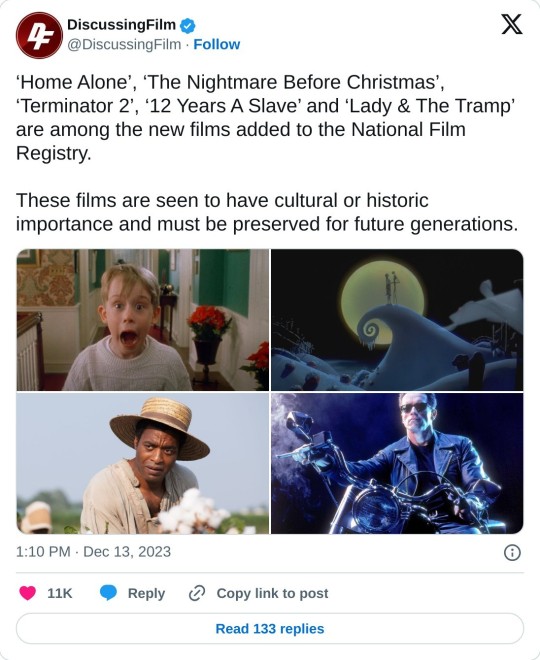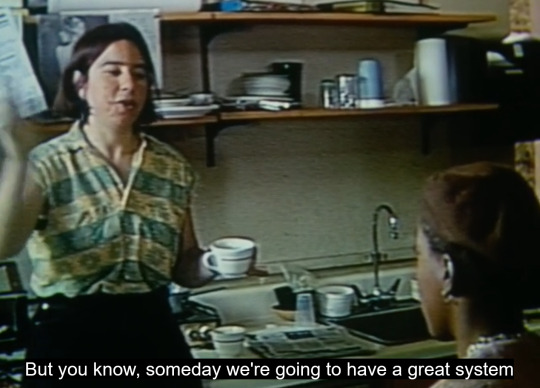#national film registry
Text


#the nightmare before christmas#nightmare before christmas#tnbc#tim burton#disney#henry selick#stop motion animation#national film registry#stop motion#december#christmas
193 notes
·
View notes
Text

Ghostbusters (1984, Ivan Reitman)
10/04/2024
#ghostbusters#film#Commedia fantascientifica#united states#1984#ivan reitman#john belushi#saturday night live#cult film#comedy film#action film#horror film#comedy#AFI'S 100 Years 100 Laughs#American Film Institute#national film registry#library of congress#Compagnia Edizioni Internazionali Artistiche Distribuzione#new york city#peter venkman#ray stantz#egon spengler#parapsychology#paranormal#new york public library#ectoplasm#sample#Hypothec#proton pack#Energia psicocinetica
75 notes
·
View notes
Text
Speaking of animated movies selected at the National Film Registry, that had me thinking…why aren’t there more Non-Disney ones?
I mean, I know Shrek is there, but what about other Dreamworks classics like Prince of Egypt or How to Train Your Dragon?
What about classics like The Iron Giant, Akira, Grave of the Fireflies, Spirited Away, or heck, ANY film directed by Hayao Miyazaki? Are these people at Library of Congress implying that none of those are culturally significant enough to be put into the National Film Registry??
How about An American Tail or The Land Before Time, two Don Bluth classics that practically dominated Disney at the box office? You’re telling me THOSE aren’t culturally significant enough??? I’m just saying there’s more to animated culture than just Disney.
#national film registry#library of congress#film preservation#animation#random rant#random ramblings
26 notes
·
View notes
Text
On October 19, 1994, Clerks debuted to a limited release in the United States.

Here's some new Jason Mewes art!
#clerks#kevin smith#jason mewes#comedy movies#comedy film#indie film#jay and silent bob#national film registry#independent film#stoner movies#stoner film#stoner art#movie art#art#drawing#movie history#pop art#modern art#pop surrealism#cult movies#portrait#cult film
29 notes
·
View notes
Text
Creating Your Own History: Archival Themes in "The Watermelon Woman" [Part 1]

An archivist speaks to the film’s protagonist about having a “great system” to organize archival records within the community archive.
The Core Values Statement of the Society of American Archivists says that archivists should expand access, respect diversity found in humanity, and advocate for archival collections that reflect humanity’s complexity. [1] The reality is often different from that ideal in a field that is overwhelmingly White, as a recent article about Black archives pointed out. [2] This is evident in Cheryl Dunye’s 1996 romantic comedy-drama film, The Watermelon Woman, which the Library of Congress added to the National Film Registry in December 2021 for being “culturally, historically, or aesthetically significant.” [3] The film follows the story of one Black woman’s determined effort to create her own history and connect with the past. Although this eighty-six-minute mockumentary is over twenty-six years old, its themes of archival limits, power, silences, erasure, and fabrication continue to resonate today.
Reprinted from The American Archivist Reviews Portal. Thanks to Rose and Stephanie for their editing of this article! It was also posted on my Wading Through the Cultural Stacks WordPress blog on Jul. 5, 2022. This review contains some spoilers for the film The Watermelon Woman.
In the film, Cheryl Dunye plays a videographer (also named Cheryl Dunye) who works at a video rental store in Philadelphia with her friend Tamara (played by Valarie Walker). Cheryl watches a videocassette of an old 1930s film, Plantation Memories, and becomes interested in the character Elsie, a stereotypical ‘mammy’ character credited as “The Watermelon Woman.” She then strives to learn more about the actress who played Elsie. One of the first places Cheryl looks is in the basement of her mother’s house. Cheryl tells the audience that her mother, played by Irene Dunye, who is Cheryl’s mother in real life, throws nothing away. She says that Irene’s filing system needs updating. Her mother tells her about the films she watched growing up in the 1930s and notes that she saw “Elsie” singing in some clubs.
Cheryl continues her dogged search by talking to a person with a collection of old Black films and then traveling to the local public library, likely the Free Library of Philadelphia. After perusing the stacks, she checks out as many books as she can and talks to the reference librarian, a White man who is played by David Rakoff. Wanting information about the Watermelon Woman, she encounters her first archival limit, which scholars Sue McKemmish, Michael Piggott, Barbara Reed, Frank Upward, Jocelyn Fenton Stitt, and Sarah Tyson define as barriers created when documents pass into the hands of archival institutions from those who created them, inhibiting attempts to use records to tell family stories and circumscribing efforts to reclaim records about enslaved people. [4]
The librarian dismissively tells Cheryl to check the “Black,” “film,” and “women” sections of reference books for information about the Watermelon Woman. With much prodding, he eventually searches his computer and identifies Martha Page as the film’s director, telling Cheryl that information about Page is on a reserve desk on another floor. Although reserve desks serve students and faculty with materials typically meant for university courses, Cheryl is given an exception and is able to access the relevant information for her research. Yet, she is still unsuccessful because the materials she looks at don’t have exactly what she is looking for.
© 2022 Burkely Hermann. All rights reserved.
Notes
[1] “SAA Core Values Statement and Code of Ethics,” Society of American Archivists, accessed February 20, 2022, https://www2.archivists.org/statements/saa-core-values-statement-and-code-of-ethics.
[2] Harmeet Kaur, “How Black Archives Are Highlighting Overlooked Parts of History and Culture,” CNN, February 19, 2022, https://www.cnn.com/2022/02/19/us/black-archivists-history-culture-cec/index.html.
[3] Nancy Tartaglione, “National Film Registry Adds ‘Return Of The Jedi’, ‘Fellowship Of The Ring’, ‘Strangers On A Train’, ’Sounder’, ‘WALL-E’ & More,” Deadline Hollywood, December 21, 2021, https://deadline.com/2021/12/national-film-registry-2021-list-star-wars-return-of-the-jedi-fellowship-of-the-ring-sounder-nightmare-on-elm-street-wall-e-1234890666/. The film is available for rent on platforms such as Vimeo, Hulu, Apple TV, Prime Video, and BFI. I watched it, using my library card, on Kanopy. It can be watched free of charge on the Internet Archive.
[4] Sue McKemmish, Michael Piggott, Barbara Reed, and Frank Upward, Archives: Recordkeeping in Society (Amsterdam, Netherlands: Elsevier, 2005), 205; Jocelyn Fenton Stitt, Dreams of Archives Unfolded: Absence and Caribbean Life Writing (New York: Rutgers University Press, 2021), 42; Sarah Tyson, Where Are the Women?: Why Expanding the Archive Makes Philosophy Better (New York, Columbia University Press, 2018), 148.
#the watermelon woman#archivists#archival science#archival studies#archival#archiving#archives#1990s#1990s films#indie films#national film registry#library of congress#mockumentary#cheryl dunye#black lesbians#lesbians#lgbtq#1930s films#racial stereotyping#archival limits
59 notes
·
View notes
Text










The Little Mermaid has been selected by the U.S. Library of Congress for preservation in their National Film Registry, making this the 10th Disney Animated Feature selected since the NFR's formation in 1988: Snow White in 1989, Fantasia in 1990, Pinocchio in 1994, Beauty and the Beast in 2002, Bambi in 2011, The Lion King in 2016, Dumbo in 2017, Cinderella in 2018, Sleeping Beauty in 2019, and now Little Mermaid. To be included in the registry, a film must be at least 10 years old and be deemed "culturally, historically, or aesthetically significant."
It's a big deal for a film to be included in the registry as, once selected, a copy is obtained from the studio/copyright holders, after which it is lovingly restored and then placed in a weather-proof and temperature-controlled vault where it will be available for future generations. So what this means is that children will still be driving their parents up the walls with Hakuna Matata and Under the Sea even after a nuclear holocaust.
Which Disney films do you want to see selected next?
#disney animation#disney#disney animated canon#disney animated movies#snow white#pinocchio#fantasia#mickey mouse#dumbo#bambi#cinderella#sleeping beauty#beauty and the beast#the little mermaid#belle#ariel the little mermaid#the lion king#animation#national film registry#library of congress#snow white and the seven dwarfs
67 notes
·
View notes
Text
Marvel Studios' Iron Man among the 25 motion pictures selected this year to be inducted into the National Film Registry

#tony stark#iron man#jon faverau#marvel's the avengers#marvel stories#robert downey jr#the avengers#marvel cinematic universe#national film registry#library of congress
94 notes
·
View notes
Text
Congratulations to the 2008 Iron Man movie for being added to the National Film Registry. Just for reference, there are only two other superhero movies in the registry; Superman (1978) and The Dark Knight.
Now that I think about it, I’m surprised that Batman ‘89 and Spider-Man ‘02 aren’t in the registry as well. Oh well.
#iron man#iron man 2008#national film registry#mcu#marvel#superhero movies#superhero films#superman 1978#the dark knight#batman 89#spiderman 2002#tony stark#robert downey jr#RDJ#movies#films
41 notes
·
View notes
Photo







Flesh and the Devil 1926
#Flesh and the Devil 1926#1926 Romantic Drama Silent Film#clarence brown#greta garbo#john gilbert#lars hanson#MGM#National Film Registry#silent film#black and white film#1920s#1920s style#1920s hollywood#the roaring 20s
93 notes
·
View notes
Text
This might sound weirdly specific, but am I the only one who thinks it’s kind of insane how Spider-man (2002) hasn’t been put on the National Film Registry yet?
I’m dead serious. Not only was it pretty significant in being a part of the superhero movie revival of the 2000s along with Fox’s X-Men, Blade, the Fantastic Four and The Incredibles etc, but Spider-man (2002) was a cultural phenomenon in of itself. Arguably paving the way for the success of its super hero/comic book-based film contemporaries. And it’s legacy is still pretty enduring 20+ years later, with countless memes spawning from the franchise and the actors from the og trilogy reprising their roles in MCU films like Spiderman: No Way Home.
I mean, if Shrek can get into the registry thanks in part to its impact on the animation landscape and the countless memes it spawned, surely Spider-Man’s inclusion is more than justified.
#film#film history#national film registry#the national film registry#spider man#spiderman#spiderman (2002)#spider-man (2002)#sam raimi#sam raimi spider man#toby maguire#William Defoe#kirsten dunst
8 notes
·
View notes
Text
December 13, 2023
By Pat Saperstein
(Variety) — The Library of Congress announced the 25 features joining the National Film Registry for 2023, with titles including “12 Years a Slave,” “Home Alone,” “The Nightmare Before Christmas” and “Terminator 2: Judgment Day.” Selected films must be more than 10 years old and are selected each year for their cultural, historic or aesthetic significance to preserve the film heritage of the U.S.
These are the 25 films in chronological order:
A Movie Trip Through Filmland (1921)
Dinner at Eight (1933)
Bohulano Family Film Collection (1950s-1970s)
Helen Keller: In Her Story (1954)
Lady and the Tramp (1955)
Edge of the City (1957)
We’re Alive (1974)
Cruisin’ J-Town (1975)
¡Alambrista! (1977)
Passing Through (1977)
Fame (1980)
Desperately Seeking Susan (1985)
The Lighted Field (1987)
Matewan (1987)
Home Alone (1990)
Queen of Diamonds (1991)
Terminator 2: Judgment Day (1991)
The Nightmare Before Christmas (1993)
The Wedding Banquet (1993)
Maya Lin: A Strong Clear Vision (1994)
Apollo 13 (1995)
Bamboozled (2000)
Love & Basketball (2000)
12 Years a Slave (2013)
20 Feet from Stardom (2013)
#National Film Registry#Library of Congress#film preservation#A Movie Trip Through Filmland#Dinner at Eight#Lady and the Tramp#Edge of the City#We're Alive#Cruisin' J-Town#Alambrista#Passing Through#Fame#Desperately Seeking Susan#Matewan#Home Alone#Terminator 2: Judgment Day#The Nightmare Before Christmas#The Wedding Banquet#Apollo 13#Love and Basketball#12 Years a Slave#20 Feet from Stardom#Variety#news
5 notes
·
View notes
Text



Welcome to the National Film Registry!!!
3 notes
·
View notes
Text

Platoon (1986, Oliver Stone)
24/03/2024
Platoon is a 1986 film, written and directed by Oliver Stone, which deals with his time in Vietnam as a volunteer during the war and is inspired by the real experiences the director had between 1967 and 1971 during his military service.
The film won 4 Oscars out of 8 nominations and Oliver Stone was also awarded the Silver Bear in Berlin as best director. In 1998 the American Film Institute placed it in eighty-third place in the ranking of the one hundred best American films of all time, while ten years later, in the updated list, it dropped to eighty-sixth place. In 2019, it was chosen for preservation in the National Film Registry of the United States Library of Congress.
The bloodiest episode, as in many other films dealing with the Vietnam War, is inspired by the most atrocious event of that conflict, known to history as the My Lai massacre, in which American soldiers committed atrocities including rape of very young girls, indiscriminate killings of innocent civilians, destruction of the homes and resources of the inhabitants, believed to be allies of the Viet Cong, despite there being no evidence. From this perspective, the figure of the platoon commander, Lieutenant Wolfe, both for his inability to control his men and for other characteristics, can be traced back to the main person responsible for My Lai, the then US Army Lieutenant William Calley, convicted to several years of military detention for that very affair.
Due to an error by Lieutenant Wolfe, who gives wrong coordinates via radio, the platoon is decimated by friendly artillery.
In the last war action of his volunteer service, Chris escapes a deadly ambush by the Viet Cong who almost completely annihilate the platoon and the subsequent American bombing with napalm.
Initially Hollywood snubs the script as many producers are of the opinion that what three is to say about the Vietnam War has already been reported in highly successful films such as Apocalypse Now and The Deer Hunter, however the strength of Stone's script still attracts some producers who see enormous potential in him. He was then assigned to write a screenplay for another film, Stone accepted and wrote Midnight Express in 1977, thanks to which he won the Oscar for best non-original screenplay (first statuette for Stone) a fact that made all of Hollywood understand the Stone's enormous potential; it was therefore not difficult for him to find the producer to begin work on Platoon.
The film was shot, following the great example of Apocalypse Now, director Francis Ford Coppola's masterpiece, on the island of Luzon, in the Philippines, starting in February 1986. The film's production was almost canceled due to the political upheavals in country, due to Ferdinand Marcos, dictator of the country. Upon arrival in the Philippines, the cast members underwent a two-week course of intensive training by Dale Dye (former Marine captain during the Vietnam War and interpreter of Captain Harris), during which they had to dig trenches and suffer forced marches and night "ambushes".
#platoon#film#1986#oliver stone#vietnam#vietnam war#1967#1971#academy awards#berlin international film festival#berlin#1998#american film institute#AFI's 100 Years 100 Movies#2019#national film registry#library of congress#united states#My Lai massacre#William Calley#friendly fire#Napalm#apocalypse now#the deer hunter#midnight express#Academy Award for Best Adapted Screenplay#francis ford coppola#luzon#philippines#ferdinand marcos
8 notes
·
View notes
Text
2 notes
·
View notes
Text
On July 22, 1993, the Director's Cut of Blade Runner debuted in Australia.





#blade runner#ridley scott#dystopian movies#dystopian science fiction#dystopian sci fi#science fiction movies#science fiction#sci fi#sci fi art#cyberpunk#climate change film#national film registry#neonoir#philip k. dick#rutger hauer#harrison ford#darryl hannah#movie art#art#drawing#movie history#pop art#modern art#pop surrealism#cult movies#portrait#cult film
23 notes
·
View notes
Text
Here’s a breather video before some big projects. If you have any interest in animated movies or the National Film Registry, this should be of interest.
youtube
4 notes
·
View notes